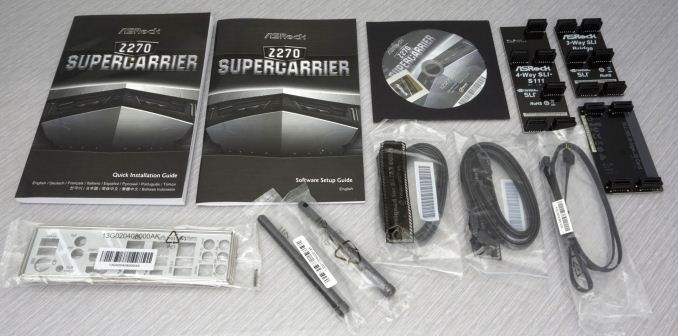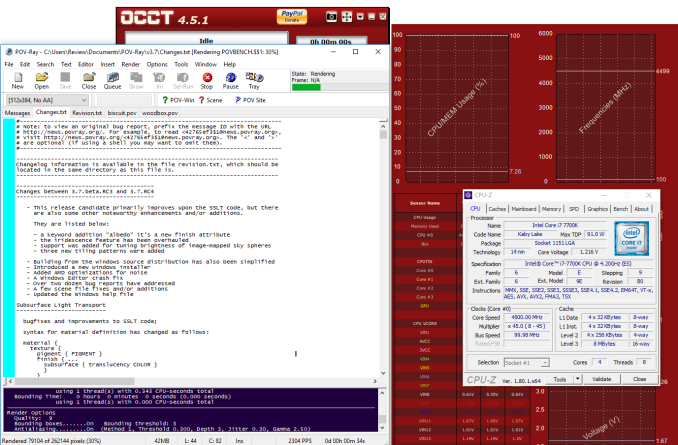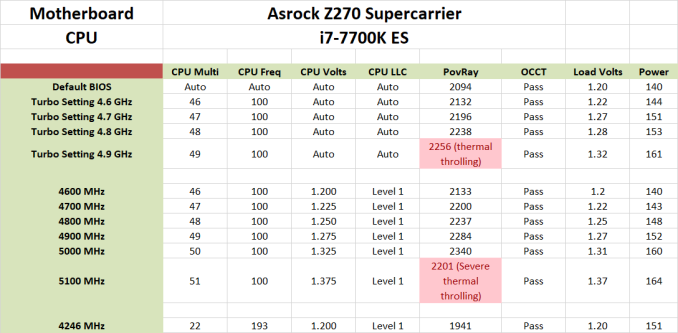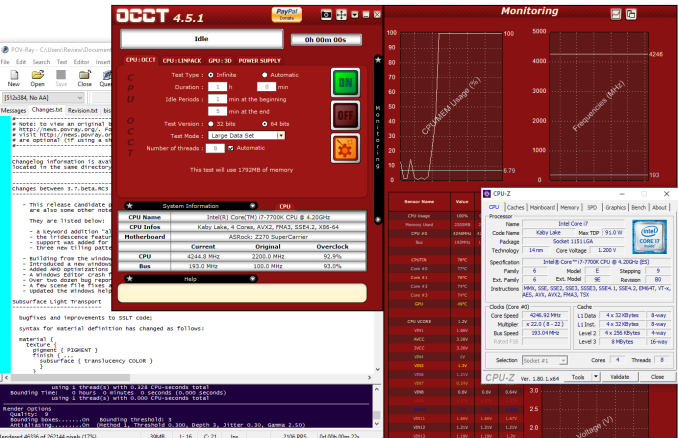The ASRock Z270 Supercarrier Motherboard Review: 4-way SLI and 5 Gigabit Ethernet on Kaby Lake
by E. Fylladitakis on September 29, 2017 9:00 AM EST- Posted in
- Motherboards
- ASRock
- SLI
- Aquantia
- Z270
ASRock Z270 Supercarrier Board Features
A quick look at ASRock’s website easily reveals that they intended the Z270 Supercarrier to be for professional designers and content editors. That, however, is a very narrow segment of the market, so the company’s engineers tried to add features that would also entice gamers and enthusiasts with larger budgets. The main highlight of the Z270 Supercarrier is the presence of four PCIe ×8 slots that allow for triple and quad SLI configurations, for either productivity or gaming. Other than that, ASRock has also added a very powerful CPU circuitry and advanced controllers that would appeal to gamers, as well as extensive storage device support that is needed by professionals. Despite the sheer number of features and supported devices, the dimensions of the Z270 Supercarrier are those of a standard ATX motherboard, ensuring compatibility with a far greater number of PC cases over an E-ATX design.
| ASRock Z270 Supercarrier | |
| Warranty Period | 3 Years |
| Product Page | Link |
| Price | Link |
| Size | ATX |
| CPU Interface | LGA1151 |
| Chipset | Intel Z270 |
| Memory Slots (DDR4) | Four DDR4 Supporting 64GB Dual Channel Up to DDR4-3733+ |
| Memory Slots (DDR3L) | None |
| Video Outputs | HDMI 1.4a DisplayPort 1.2 |
| Network Connectivity | AQC108 / Intel I219-V / Intel I211-AT |
| Onboard Audio | Realtek ALC1220 |
| PCIe Slots for Graphics (from CPU) | 4 × PCIe 3.0 via PEX 8747 (×16/×16, ×16/×8/×8, ×8/×8/×8/×8) |
| PCIe Slots for Other (from PCH) | 1 × PCIe ×1 |
| Onboard SATA | Six, RAID 0/1/5/10 |
| Onboard SATA Express | Two |
| Onboard M.2 | 3 × PCIe 3.0 (x4) |
| Onboard U.2 | None |
| USB 3.1 | Two Type-C (Intel JHL6540) |
| USB 3.0 | 4 x Type-A Rear Panel 4 × via headers 1 × Type-A onboard |
| USB 2.0 | 2 × Rear Panel 4 × via headers |
| Power Connectors | 1 x 24-pin ATX 1 x 8-pin CPU 1 x 6-pin GPU |
| Fan Headers | 1 x CPU (4-pin) 1 x Pump/Aux (4-pin) 3 x System (4-pin) |
| IO Panel | 4 x USB 3.0 (USB 3.1 Gen 1) 2 x USB 2.0 2 x USB 3.1 Type-C/Thunderbolt 3 1 x CMOS Reset Button 3 x Network RJ-45 1 x DisplayPort 1.2 1 x HDMI 1.4a 1 x Combo PS/2 5 x 3.5 mm Audio Jacks 1 x Optical SPDIF Out Port |
| Other Features | WiFi/BT Onboard Supports Intel® Optane™ technology Front Audio Header w/ TI NE5532 amplifier COM port header RGB lighting Dual LAN with Teaming |
In The Box
We get the following:
- Driver Disk
- Quick Installation Guide
- Software Setup Guide
- Rear I/O Shield
- Four black SATA cables (two straight, two with a 90° connector)
- SLI HB bridges (2-way, 3-way, and 4-way)
- RGB strip cable
- Wireless antennas
- Case badge
The items bundled alongside with the Z270 Supercarrier begin with a standard manual, a drivers/software DVD, a metallic I/O shield, a case badge, and four SATA cables; ordinary items that can be found accompanying almost any motherboard. However, we also find an extra cable for external RGB strips, two wireless antennas, and three HB SLI bridges. The HB SLI bridges are specially designed so as to support the NVIDIA GTX 1080 GPUs. However, we found the inclusion of typical antennas strange, as they often are the cause of space issues behind a case. A single wired antenna such as the one ASRock supplies with the Z270 Gaming-ITX/ac would have been much more convenient.
ASRock Z270 Supercarrier Overclocking
Experience with ASRock Z270 Supercarrier
Although the main target group of the Z270 Supercarrier are professionals, most of which are unlikely to do any overclocking at all, ASRock included a wealth of overclocking options and advanced circuitry to support it. This was probably an effort to make the Z270 Supercarrier a competitive option for enthusiastic gamers with large budgets. No matter the reason, the Z270 Supercarrier does have both the hardware and the software to support extensive overclocking. The power circuitry is excellent and the BIOS is very flexible, with the voltage and frequency options having excellent range and step.
Methodology
Our standard overclocking methodology is as follows. We select the automatic overclock options and test for stability with PovRay and OCCT to simulate high-end workloads. These stability tests aim to catch any immediate causes for memory or CPU errors.
For manual overclocks, based on the information gathered from previous testing, starts off at a nominal voltage and CPU multiplier, and the multiplier is increased until the stability tests are failed. The CPU voltage is increased gradually until the stability tests are passed, and the process repeated until the motherboard reduces the multiplier automatically (due to safety protocol) or the CPU temperature reaches a stupidly high level (100ºC+). Our test bed is not in a case, which should push overclocks higher with fresher (cooler) air.
Overclock Results
At this point we should again mention that the ASRock Z270 Supercarrier has multi-core turbo enabled by default, which is common, but also has a default turbo multiplier of ×45 rather than ×44, essentially overclocking our 7700K CPU to 4.5 GHz by default.
Testing the automated overclock options proved that ASRock’s overclocking presets will work fine for users that do not want to concern themselves with detailed settings. The automated setting however are, as expected, a little too generous with the voltage. Our system was working fine with the Turbo CPU setting up to 4.8 GHz but any further than that would raise our processor’s temperatures too high and trigger thermal throttling. Better cooling solutions and a lucky CPU pick can yield much better overclocking results if done manually. Manual control allowed us to reach a fully stable overclock of 5.0 GHz. Ultimately, what limited us was the thermal performance of our CPU and not the motherboard.
The ASRock Z270 Supercarrier also handles high BCLK frequencies very well. We managed to reach a fully stable frequency of 193 MHz with virtually minimal tweaking. Note that the newer motherboard designs decouple the CPU bus from the rest of the frequency domains in order to allow for these high BCLK overclocks, meaning that the performance of other components and the system’s overall bandwidth remains unaffected. On the contrary, frequency misalignments can cause an overall performance drop. Thus, this technique is useless to users who have unlocked CPUs and should be used only to overclock locked CPUs.














50 Comments
View All Comments
edzieba - Saturday, September 30, 2017 - link
A 'headphone amplifier' is just an op-amp used correctly in its linear region. Marketing departments may wish to tell you otherwise, but there is nothing magical about them.extide - Friday, September 29, 2017 - link
WHY are we still seeing boards with SATA Express... That just needs to die!Regular Reader - Sunday, October 1, 2017 - link
Same reason this motherboard still has PS/2 on it.Samus - Saturday, September 30, 2017 - link
Is triple\quad SLI still a think? I mean, at what point are 2x 1080Ti's or 2x Vega64's not good enough for any game at any reasonable resolution even across multiple monitors?Regular Reader - Sunday, October 1, 2017 - link
Apparently there are enough buyers still out there (for multiple motherboard vendors no less) that want the braggingest brag of a gaming rig out there, regardless of the paltry 5% performance increase 3 and 4 cards affords.Notmyusualid - Sunday, October 8, 2017 - link
Its not all about gaming....CrazyHawk - Friday, October 6, 2017 - link
There are other uses for 4-way GPUs other than gaming. An inexpensive deep-learning rig is one of them. 16 PCI 3 lanes still provide 15.8 GB/second total bandwidth. With the PEX 8747 chip (in a 2-GPU system), if a single card is exchanging data with the CPU, it gets the entire 15.8 GB/second bandwidth, and GPU to GPU transfers are at 15.8 GB/second without involving the CPU.On GoogLeNet, with a GTX 1070, time spent transferring data at x16 is about 3% of runtime. With AlexNet (same hardware), it is about 5.5% of runtime. That means that for 95% of the job, there is no data going over the PCI x16 links. The PEX 8747 can give full access to the 16 PCI lanes to each GPU during that 95% of the time. With 4 GPUs, each gets x8 lanes, so the transfer time doubles, but it is still just around 10% of runtime, and only 40% of the total bandwidth is used (this analysis ignores optimizations possible through pipelining the data transfer with the compute).
The GTX 1080Ti is about twice the speed as the GTX 1070, so with 4 1080Ti cards, you are using near 80% of the bandwidth, which starts to become a stretch. But if you can afford 4 1080Ti cards, you can probably afford an HEDT machine. For getting started with deep learning, this motherboard, an 8700K processor, and 4 used GTX 1070 or GTX 1060 GPUs (after the mining craze goes bust) would be a very inexpensive way to build a real AI supercomputer.
Does anyone have any rumors/ideas on when the z370 version of this board will come out? (or the ASUS z370-WS version of their board?)
Notmyusualid - Sunday, October 8, 2017 - link
@ CrazyHawkPeople have been telling me since 2007, that mining is going to go bust:
1 Bitcoin equals 4469.43 US Dollar
Mining has changed, but alive & kicking!
oranos - Monday, October 2, 2017 - link
nobody knows how to push the irrelevant innovation of hardware quite like the ethernet industrywagletops - Tuesday, October 3, 2017 - link
save all these reviews for when the 370 comes out :)http://www.appcheatsonline.com/roblox-robux/